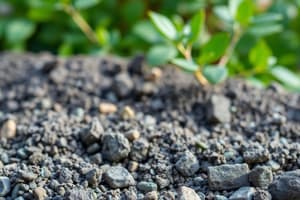Podcast
Questions and Answers
What is the difference between renewable resource and a nonrenewable resource?
What is the difference between renewable resource and a nonrenewable resource?
- Nonrenewable resources can be replenished quickly.
- Both resource types are identical.
- Renewable resources can be replenished over a short amount of time. (correct)
- Nonrenewable resources take millions of years to replenish. (correct)
What is an example of a renewable resource?
What is an example of a renewable resource?
solar power
What is an example of a nonrenewable resource?
What is an example of a nonrenewable resource?
fossil fuels
What is any hydrocarbon that can be used as fuel?
What is any hydrocarbon that can be used as fuel?
Name 3 most important fossil fuels.
Name 3 most important fossil fuels.
What substance is formed when heat and pressure transform plant material over millions of years?
What substance is formed when heat and pressure transform plant material over millions of years?
What is the first stage of coal formation?
What is the first stage of coal formation?
What is the second stage of coal formation?
What is the second stage of coal formation?
What is the third stage of coal formation?
What is the third stage of coal formation?
What is the last stage of coal formation?
What is the last stage of coal formation?
What is partially decayed plant material that looks like soil?
What is partially decayed plant material that looks like soil?
What sedimentary rock is often called brown coal?
What sedimentary rock is often called brown coal?
What is another sedimentary rock, or soft coal?
What is another sedimentary rock, or soft coal?
What type of coal is known as hard coal?
What type of coal is known as hard coal?
Name different uses of coal.
Name different uses of coal.
What are the disadvantages of coal?
What are the disadvantages of coal?
What is oil and natural gas and how were they formed?
What is oil and natural gas and how were they formed?
How is oil extracted?
How is oil extracted?
What is the requirement for oil to be pumped out?
What is the requirement for oil to be pumped out?
Name two disadvantages in using oil.
Name two disadvantages in using oil.
What are mixtures of clay and sand combined with water and varying amounts of tar called?
What are mixtures of clay and sand combined with water and varying amounts of tar called?
What is rock that contains a wavy mixture of hydrocarbons called kerogen?
What is rock that contains a wavy mixture of hydrocarbons called kerogen?
What is the source of solar energy?
What is the source of solar energy?
What is the source of nuclear energy?
What is the source of nuclear energy?
What is the source of wind energy?
What is the source of wind energy?
What is the source of geothermal energy?
What is the source of geothermal energy?
What is the source of tidal power?
What is the source of tidal power?
What is the source of biomass & biofuels?
What is the source of biomass & biofuels?
What is the source of hydrogen & fuel cells?
What is the source of hydrogen & fuel cells?
What are the positives and negatives of solar energy?
What are the positives and negatives of solar energy?
What are the positives and negatives of nuclear energy?
What are the positives and negatives of nuclear energy?
What are the positives and negatives of wind energy?
What are the positives and negatives of wind energy?
What are the positives and negatives of geothermal energy?
What are the positives and negatives of geothermal energy?
What are the positives and negatives of tidal energy?
What are the positives and negatives of tidal energy?
What are the positives and negatives of biomass & biofuels?
What are the positives and negatives of biomass & biofuels?
What are the positives and negatives of hydrogen and fuel cells?
What are the positives and negatives of hydrogen and fuel cells?
What are two gases that contribute to global warming?
What are two gases that contribute to global warming?
What are the consequences of global warming?
What are the consequences of global warming?
Name 3 ways to conserve natural resources.
Name 3 ways to conserve natural resources.
What type of coal contains 85% carbon?
What type of coal contains 85% carbon?
What type of coal contains 40% carbon?
What type of coal contains 40% carbon?
What type of coal contains 95% carbon?
What type of coal contains 95% carbon?
Study Notes
Renewable vs Nonrenewable Resources
- Renewable resources can be replenished in a short timeframe.
- Nonrenewable resources require millions of years for replenishment.
Examples of Resources
- Solar power serves as a prime example of a renewable resource.
- Fossil fuels, such as coal, oil, and natural gas, exemplify nonrenewable resources.
Fossil Fuels
- Fossil fuels are hydrocarbons used as fuel.
- Important fossil fuels include coal, oil, and natural gas.
Coal Formation Stages
- The first stage of coal formation is peat, consisting of partially decayed plant material resembling soil.
- Lignite is the second stage, often referred to as brown coal.
- Bituminous coal represents the third stage, also known as soft coal.
- Anthracite is the final stage of coal formation, classified as hard coal.
Uses and Disadvantages of Coal
- Coal is utilized for heating, recycling, and steel manufacturing.
- Disadvantages include being a nonrenewable resource and contributing to global warming.
Oil and Natural Gas Formation
- Oil and natural gas originate from the remains of ancient plants and animals buried in seas over millions of years.
Oil Extraction
- Oil is extracted by drilling into the ground and pumping it out, requiring suitable equipment.
Disadvantages of Oil
- Oil is a nonrenewable resource and contributes to greenhouse gas emissions.
Alternative Energy Sources
- Solar energy source: the sun.
- Nuclear energy source: radioactive isotopes.
- Wind energy source: wind.
- Geothermal energy source: hot water.
- Tidal power source: tides.
- Biomass and biofuels source: decomposed living materials.
- Hydrogen and fuel cells source: reaction of hydrogen and oxygen.
Advantages and Disadvantages of Various Energy Sources
- Solar Energy: Clean and renewable; however, it has high initial costs.
- Nuclear Energy: Does not contribute to global warming; lacks safe disposal methods.
- Wind Energy: Renewable but can be noisy.
- Geothermal Energy: Clean and renewable; however, associated costs are high.
- Tidal Energy: Clean but requires high capital investment.
- Biomass & Biofuels: Widely available; however, land availability can be an issue.
- Hydrogen & Fuel Cells: Plentiful but expensive to implement.
Global Warming Factors and Consequences
- Key gases contributing to global warming include carbon dioxide and water vapor.
- Consequences of global warming encompass the spread of diseases, warmer ocean waters, and increased hurricane activity.
Resource Conservation Strategies
- Effective strategies to conserve natural resources include recycling, improving efficiency, and managing resources wisely.
Carbon Content in Coal Types
- Bituminous coal contains approximately 85% carbon.
- Lignite has around 40% carbon content.
- Anthracite features the highest carbon content at approximately 95%.
Studying That Suits You
Use AI to generate personalized quizzes and flashcards to suit your learning preferences.
Description
Test your knowledge on the differences between renewable and nonrenewable resources. This quiz covers examples like solar power and fossil fuels, as well as the stages of coal formation and their uses. Challenge yourself to identify key concepts and their implications for energy.




